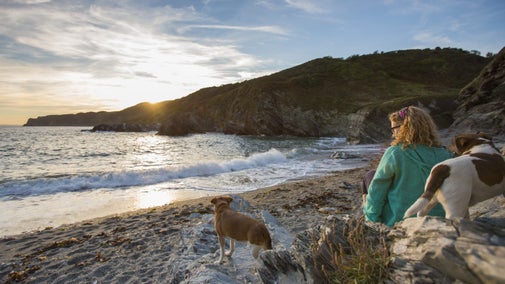
Discover more at Baggy Point
Find out how to get to Baggy Point, where to park, the things to see and do and more.

Baggy Point offers views of Lundy Island, and the beaches at Woolacombe and Croyde. Over 70,000 people walk out to the point each year to enjoy the sights and see what wildlife can be spotted along the way. With walks to suit all ages, it’s a place to blow away the cobwebs and enjoy all that nature has to offer along the North Devon coast.
Going on a family walk to Baggy Point is an adventure for all ages. With far reaching views throughout the year, it’s also pushchair accessible right up to the pond.

The rugged coastline is a haven for many types of seabirds. As well as herring gulls and the fulmar, there’s also a chance to see globally threatened red status birds like the shag, a dark, large bird that breeds locally on Lundy Island.
Common guillemots and razorbills prefer the high cliffs when choosing a place to build their nests, and Dartford warblers and stonechats perch and sing on top of the gorse. Keep an eye out for cormorants.
Grey seals swim and play in the waters around Baggy Point, although more will be seen during the summer months. A good way to spot these curious creatures is to follow the easy access walk.
Thanks to some clever invisible fencing, four Ruby Red cattle have joined the wildlife and are playing their part in keeping this habitat diverse. The cattle help to keep the area from becoming overgrown.
- Jonathan Fairhurst, National Trust Lead Ranger

Throughout the year, Hebridean sheep graze on the rough ground around the footpaths. Native to Scotland, these little black ewes thrive in all conditions and are excellent mothers. By the summer, the fields are filled with young lambs.
Middleborough Hill, adjacent to the Baggy Point car park, has undergone a transformation in recent years. It was sown with wildflower seeds and has turned into a colourful meadow and orchard. It’s now a place where wildlife can thrive and everyone can sit and admire the view.
The rare brown banded carder bee was spotted at Baggy Point recently, after 20 years of being absent. It’s a nationally important species which was once found widely across Devon, but is now confined to just a few small sites along the North Devon coast.
This bee tends to fly later in the summer so there is often little forage for it to feed, as modern farming pressures tend to require fields to be cut much earlier in the year.
The survey work was carried out in conjunction with Bumblebee Conservation Trust as part of their Westcountry Buzz project. The project focusses on improving bumblebee habitat across North Devon. The Bumblebee Conservation Trust also contributed towards sowing the wildflower seed.

Find out how to get to Baggy Point, where to park, the things to see and do and more.
From short family walks to something more challenging for the surfer in the family. Grab a board or your walking boots at Baggy Point and enjoy the crisp, fresh air in a rugged landscape.

If you’re feeling peckish, why not treat yourself to a bite to eat and a hot or cold drink from Sandleigh Tea-Room in Croyde? With seating inside and out, it’s just the place to recharge your batteries.

Discover how the generosity of the Hyde family brought Baggy Point to the care of the National Trust.

Discover the 890 miles of beautiful coastline in our care. Plan your next coastal adventure, whether you want to explore soft, sandy beaches or rugged, windswept cliffs.

While canoeing and kayaking are great ways to experience nature and keep fit, they can be dangerous if you don't follow the guidelines. Learn how to stay safe with our advice and guidance.

Try out the ‘50 things to do before you’re 11¾’ activities children can enjoy by the sea, from paddling or swimming, to catching crabs and skimming stones.

The beaches and coast along the rugged Devon landscape are ideal for a day out with the family. Take a coastal walk in the fresh air or enjoy games on the beach.
